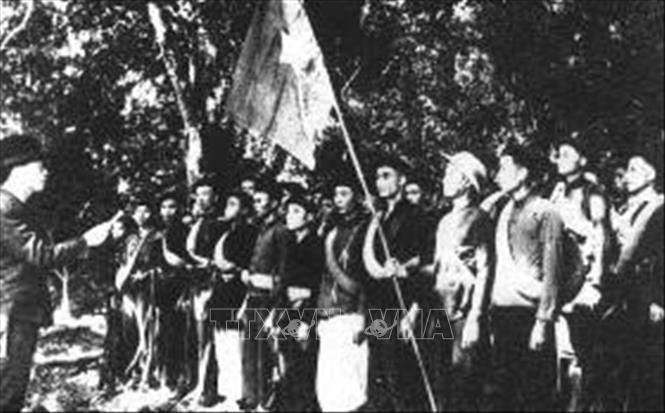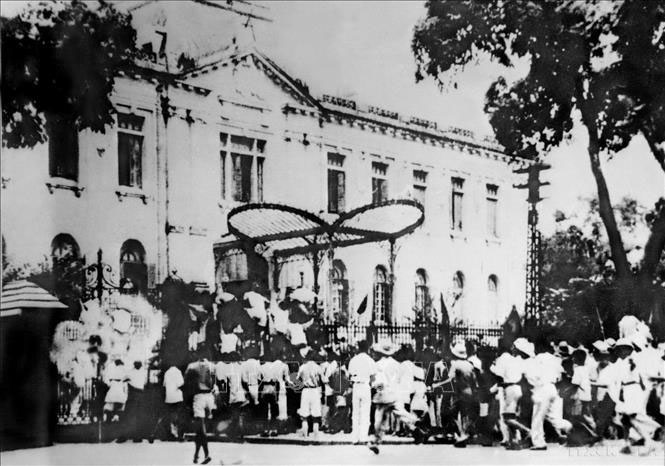From "The Emperor's forces" to "Viet Minh"
The August Revolution of 1945 is one of the greatest and most glorious events in the history of thousands of years of building and defending the country of the Vietnamese people. In just a short time of 15 days, a nation that had been under the protection of the capital for nearly a century had risen to the rank of the chain of French colonialism and the domination of Japanese socialism, overthrow the thousand-year-old specialist monarchy, and give birth to the Democratic Republic of Vietnam.
That miraculous victory is the result of many factors: The decline of the colonial - feudal regime, favorable international conditions when the Second World War ended, and above all, 15 years of hard and steadfast preparation for the entire nation under the wise leadership of the Indochinese Communist Party and leader Ho Chi Minh. Among the countless factors that made victory, the construction, organization and promotion of the strength of the United National Front, whose peak was the Viet Minh Front, emerged as the leading decisive factor. This is not only an organization to gather forces, but also the embodiment of the art of national unity, a symbol of the will and aspiration for independence of the nation.
The Front has succeeded in turning the potential strength of the masses into a great material force, combining the talent of political, military and diplomatic struggle, and above all, has seized the "one-on-one opportunity" to lead the people to gain power. The victory of the Viet Minh Front in 1945 was not a random success, but the result of the process of exploring, testing and developing the long-term strategic thinking of the Communist Party on the issue of national unity.
Right from the founding of the Party in 1930 in the first political platform, leader Nguyen Ai Quoc mentioned the need to "revive the majority of the workers" and form alliances with other forces. However, due to the influence of the " released" trend in the Communist International at that time, the October 1930 political climate over emphasized the issue of class struggle, emphasizing the interests of farming without fully recognizing the role of other classes. The policy of establishing the "Allied Monarchical Council" is a step forward, but it is still a class issue, not enough to call on the entire nation.
The first turning point in the Front's thinking was the period of 1939. Faced with the risk of socialism, the Party has flexibly changed direction and policies to establish the Indochina Democratic Front. The goal now is to demand freedom, people's livelihood, democracy, food and peace. The temporary placement of the slogan "ckuring the empire" to focus on the immediate goal has helped the Party gather a large mass force, including intellectuals, small nobles, and even a part of the national nobility. This is an important "exercise", helping the Party accumulate valuable experience in organizing and leading the masses to fight openly and sell publicly.
However, the decisive turning point only really came at the 8th Central Conference (May 1941) chaired by leader Nguyen Ai Quoc at Pac Bo. When World War II broke out and Japan entered the Indochina, the conflict between the entire Vietnamese nation and the socialist empire became more intense than ever. The conference issued a historic decision: Put the task of national liberation first, "the rights of the department and class must be placed above the life and death of the nation and the nation".
From that strategic assessment, the Conference decided to establish the Vietnam independent and Allied Front, abbreviated as Viet Minh. This is a genius creation. The name "Vietnam Independence Allied" itself is a metaphor, a call-up, focusing on the two most core words: "Vietnam" and "Independence". It no longer discriminates between classes, religions, and policies, but extends the solidarity hand of "all patriotic peoples", regardless of who they are, as long as they share the common goal of repelling Japan - France, gaining independence for the Fatherland. The birth of Viet Minh has completely untied the bonds of previous class thinking, making patriotism the main driving force, the largest common model to gather the strength of the entire people.
Organizing the flag to promote the strength of the entire nation
Not only is it a correct policy, Viet Minh also proves his strong vitality through a flexible organizational model and the ability to promote the extraordinary strength of the masses. The role of the Viet Minh Front stands out when successfully carrying out the mission of gathering the entire people, playing a decisive role in the victory of the revolution.
First of all, Viet Minh builds a comprehensive and unified organizational system. Instead of a common front, Viet Minh is specifically restructured through the " Savior's Committees" (Savior Farmers' Association, Savior Workers' Association, Savior Youth Association, Savior Women's Association, Savior's Elderly Association, Savior Children's Association...).
The Party even mobilized the establishment of the National Defense Culture Association to gather intellectuals and artists. This model allows all people, regardless of age, gender, or occupation, to find their place in the common struggle. The Savior's Associations are both places of propaganda and enlightenment, schools for training and coaching cadres, and the core of the movement at the grassroots level.
Another key factor is that Viet Minh has combined political struggle skills with building armed forces. The Front not only mobilized the masses to protest and attack, but also directly organized the armed forces. From the guillotine and National Defense teams, the Party and Viet Minh have moved towards establishing the Vietnam Propaganda Liberation Army Team (December 22, 1944).

This is a remarkable development step, turning the political forces of the masses into organized military forces. The role of Comrade Vo Nguyen Giap in the establishment of this main army is to realize the policies of the Party and leaders of Ho Chi Minh, creating a core military "fight" for the uprising.
At the same time, the construction of revolutionary bases such as Viet Bac into "Liberation Zone" (June 1945) has strategic significance. It is not only a safe rear, but also a "minorized image of the new Vietnam", where Viet Minh's policies are piloted, creating strong trust for the people.
Along with that, Viet Minh conducts propaganda and encouragement work creatively and effectively. Clearly recognizing the importance of ideological work, Viet Minh has used all forms to bring the revolutionary guidelines to the masses. The press (Flag of Liberation, Savior, Vietnam Independence), leaflets, poetry, short stories, drama... have become sharp weapons.
The slogans are given very specifically and practically, meeting the urgent aspirations of the people. In particular, when the terrible hunger occurred at the end of 1944 and the beginning of 1945, Viet Minh's slogan "Put up the corn, solve hunger" had a terrible impact. It not only solves the immediate problem of people's lives but also exposes the crimes of Japanese socialism and the helplessness of the government's compensation, thereby "sets up with the people's hearts", causing millions of farmers in abscess to turn to the revolution.
One of the outstanding successes of the Front was diplomatic activities directly led by leader Ho Chi Minh. Viet Minh not only fought against the enemy but also proactively sought allies. By contacting and cooperating with the Dongming force, specifically the US Strategic Intelligence Service (OSS), Viet Minh has positioned itself as the main and only anti-racist force organized in Indochina.
This proactive conduct of diplomatic struggle has brought double benefits: both taking advantage of (though limited) support in weapons, platforms, and training, and creating an international "reputation". It was this "anti-Facist alliance" that facilitated Viet Minh's declaration of independence, making the plot of the French colonialists' return a lost and unrequited one.
The art of seizing the opportunity in the General Uprising under the Front's flag
Careful preparation for 15 years is a necessary condition, but the art of seizing on opportunities is a sufficient condition to decide victory. When the Japanese socialists suddenly took control of France (March 9, 1945), the Central Party Standing Committee immediately issued a Directive "Japan - France Shooting Each Other and Our actions".
This is a document that shows extreme political acumen. The Party believes that the main enemy, specifically at this time, is Japanese factionalism. A "deep political crisis" broke out, creating conditions for a strong resistance movement to save the country, as a premise for the General Uprising.
On August 15, 1945, when Nhat Hoang declared the unconditional surrender of Dongming, "a time of a thousand years" was scored. The Japanese army in Indochina seemed to lose its head, the authorities took advantage of Tran Trong Kim's paralysis, while the Dong Minh army had not yet landed. This is a priceless "power space". Immediately, the National Party Conference (10.08) and the National Assembly trieucted by Viet Minh in Tan Trao (10.17) decided to launch a General Uprising nationwide.
The Tan Trao National Assembly is the pinnacle of the role of the Viet Minh Front. The Congress not only gathered representatives of the entire people but also acted as a provisional National Assembly, electing the Vietnam Committee for the Liberation of Ethnic Minorities (ie the Provisional Government) chaired by Ho Chi Minh. This action granted the General Uprising the highest honor. The uprising order (Army Command No. 1) was issued, and the revolutionary wave spread throughout the country.

In localities, it was the Viet Minh Party Committees of provinces, districts and communes that directly led the mass uprising. In Hanoi (19.8), Hue (23.8) and Saigon (25.8), the protests of tens of thousands of people under the Viet Minh flag quickly turned into armed uprising, seizing the enemy's brain agencies. In the South, the Southern Party Committee has creatively applied "multi-ended successor" when leading the Forward Youth Organization, a public organization sponsored by Japan, became a powerful revolutionary force. When the opportunity arose, this organization immediately followed Viet Minh, becoming the core force in the uprising in Saigon.
The entire process of the General Uprising was a smooth coordination between the political forces of the masses (organized by the Front) and the armed forces (built by the Front). The overwhelming power of the masses paralyzed the Japanese army, did not dare to intervene, and the compensatory government quickly disbanded, helping the revolution win a quick, complete victory with little blood.
From perfecting strategic thinking, putting national interests first, to creating a flexible " Savior's Army" organization model; from building a widespread political force to organizing a key army; from effective propaganda work to skillful diplomatic struggle; and finally the art of seizing the opportunity to launch a national rebellion - all of which bear the imprint of the Front's thinking.
Viet Minh has succeeded in turning patriotism into organized material strength, gathering all classes of people under the great flag, creating a great epic of the 20th century. Lessons on promoting the strength of great national unity through a unified Front, placed under the leadership of the Party, still have the same hot value. That is not only the key to the victory of the August Revolution, but also an invaluable heritage, a core motivation for the Vietnamese people to firmly step into a new era of development, an era of strong growth in today's context of globalization.











